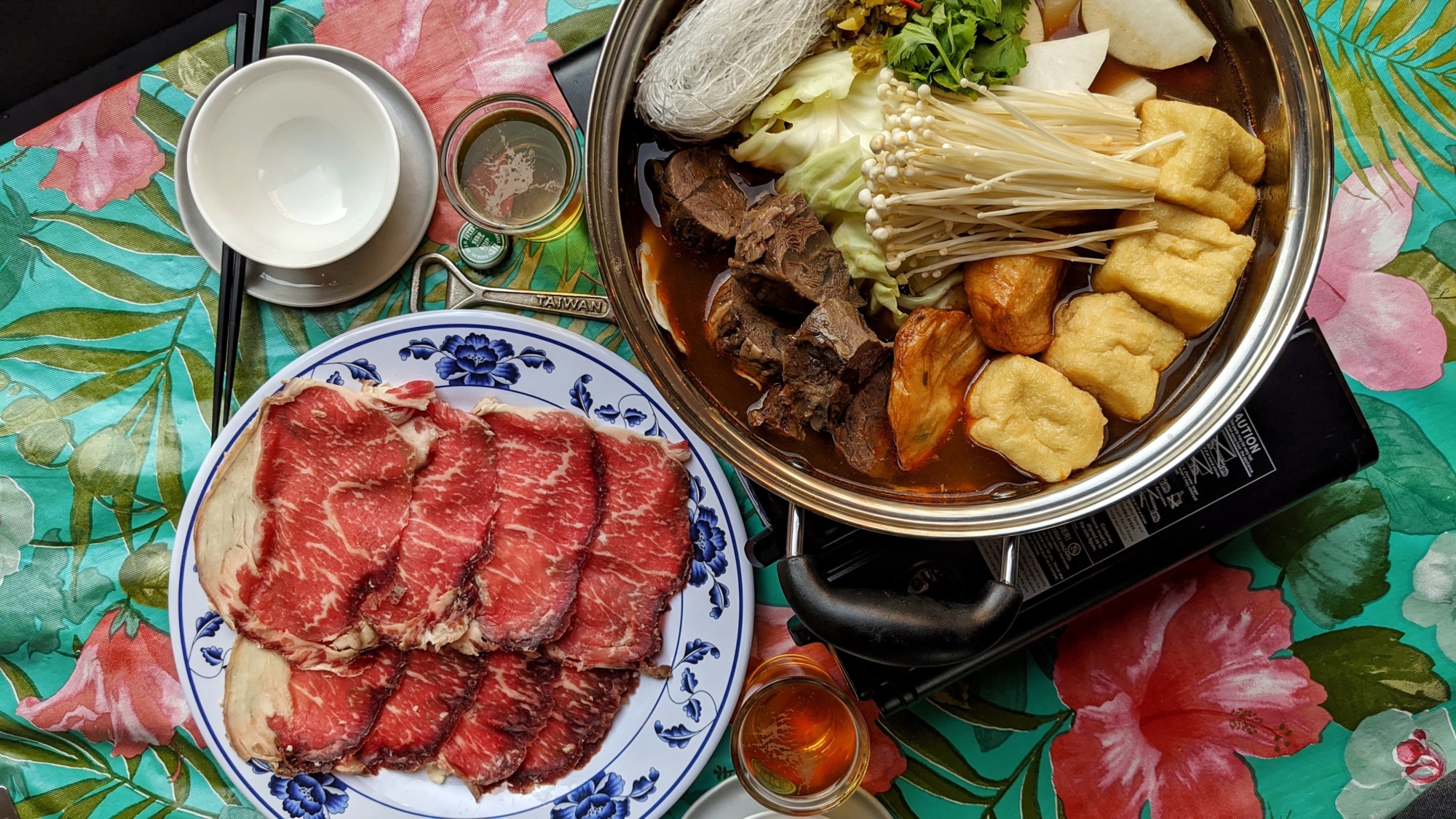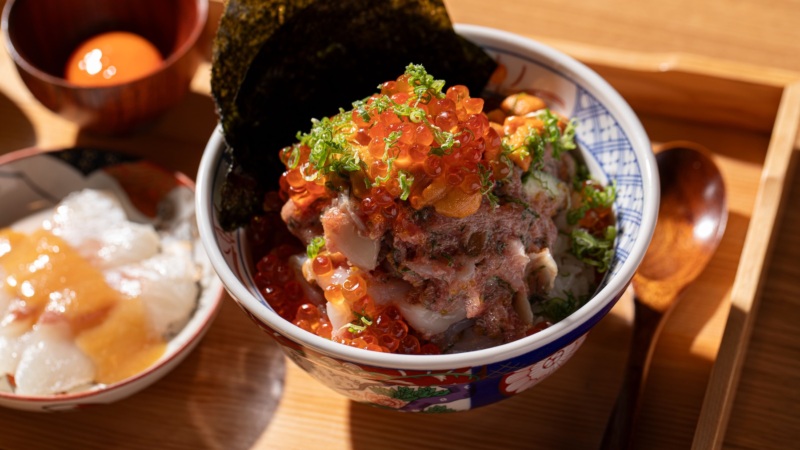
A Chef’s Guide to Creating Asian-Style Hot Pot at Home
The beauty of an Asian-style hot pot is that no hot pot meal is ever quite the same, and there are so many different styles and flavors to choose from. And while there’s much joy to be found in doing hot pot at a restaurant, it’s much easier to do at home than you might think.
During the shutdown earlier this year, 886 chef-owner Eric Sze had homemade hot pot meals at least twice a week. Over the years, he says, he’s also gained a deeper appreciation for hot pot: It’s much more than just cutting things up and throwing them into a pot of boiling stock. It’s a way to explore different textures, cooking times, and ingredients. And most of all, it’s delicious, year-round. This fall, he began offering hot pot at his Taiwanese restaurant in New York’s East Village.
Also in New York, over at Saigon Social, chef-owner Helen Nguyen recently hosted a hot pot event and has plans to do more this winter.
As more diners learn to love hot pot at restaurants like 886 or Saigon Social, Sze and Ngueyn hope they’ll also try doing their own hot pot meals at home.
“Just take the leap,” says Sze. “The first time will be the hardest, but every single time after that, you will improve and get better. The world is your hot pot oyster.”
***
Tip No. 1: Make sure you have the right equipment.
Invest in an induction cooktop. While they’re more expensive than a portable butane stove, they’re worth the extra cost, there’s less margin for error, and they’re generally safer. “It’s less fuss, and you never have to worry about never buying the butane,” Sze explains.
Go to your nearest Asian supermarket to get your induction-safe pot. Choices include a single pot or a hybrid one that has a divider to hold two separate broths at once. If you don’t want to buy a separate pot for hot pot, Sze says you can also use your Dutch oven.
Have an array of bowls and plates at the ready: one set for your diners, and others to hold your hot pot spread of ingredients.
Invest in a few soup ladles, both with and without holes. The slotted spoons will help you scoop up your cooked items from the pot during the meal.
And make sure you have chopsticks, too. “You don’t want to fork around in the broth,” Sze says. “If you suck with chopsticks, use a tong.”
Tip No. 2: Figure out your broth(s) situation.

Store-bought is more than fine when it comes to hot pot soup bases. But don’t be afraid to modify them to your tastes. “Think of the soup base as an ingredient, and not a finalized product,” Sze says.
Nguyen adds aromatics like onions, lemongrass, ginger, shallots, roasted garlic, cardamom, chilli oil, and scallions to her broth. She’s partial to the Quốc Việt Foods line of soup bases, especially the Cốt Bún Bò Huế flavor, heavy on lemongrass.
Sze recommends Haidilao’s mushroom flavor seasoning, to which he often adds chicken broth to cut down on the saltiness.
If you opt for a hybrid hot pot that can serve two different broths at a time, it’s traditional to offer a more mellow, non-spicy soup base and a spicier soup base, but it’s really up to you and your guests what broths you’d like to have.
Don’t forget there’s a wide range of styles and flavors of soup bases to choose from, too. Nguyen’s mom would often serve a Vietnamese-style hot pot broth with a simple pork or chicken stock, or sometimes she’d even stew fish heads and add a tamarind base to it, served alongside taro stems and rice paddy herbs.
Growing up in Taiwan, Sze had a lot of spicy Sichuan-style hot pot with a doubanjiang (broad bean chilli sauce) base. Non-spicy broths were bonito pork, or chicken broth, influenced from Japan. Right now, he’s been interested in exploring more Cantonese-style hot pot that uses fish or beef stock and super-fresh beef. At 886, the hot pot soup base is the same broth used in Taiwanese beef noodle soup.
Whatever broths you eventually settle on, bring them up to a boil before you start dipping in your food to eat. And if the broth starts to reduce during your meal, feel free to add more stock or hot water to replenish the broth, as needed.
Tip No. 3: Start preparing your spread.
There are four main categories for hot pot ingredients, each with “endless possibilities,” says Sze.

Proteins
- Pre-sliced meats from your nearest Asian grocery store are the simplest (and easiest) approach. You can usually find lamb, pork, beef, and chicken. Sze prefers lamb and beef, while Nguyen loves pork belly.
- If you can, however, it’s better to slice your own meat. “I like to hand slice short rib meat and, because I’m not very good at it, it yields almost a quarter-inch cut, so when I put it into the hot pot, it’s like a perfect medium rare,” Sze explains. Use an extremely sharp knife.
- For any type of offal, like tendon or tripe, you’ll need to do some pre-cooking and braising.
- The varieties of tofu that you can use for hot pot are endless. Sze’s favorite is non-fried tofu skin, while Nguyen’s is a soft, silken tofu. Nguyen will sometimes fry her tofu ahead of time to give it a different texture, too.
- Sze has a hack for improving the texture of silken tofu for hot pot: Cutting it up into cubes and freezing the tofu cubes overnight. “When you pop tofu into the freezer, it forces the air to come and it creates air bubbles in the tofu and it becomes a sponge that soaks up all the flavors of the broth,” he explains. “It’s a completely different mouthfeel. It’s super low lift, too.” Just before you’re about to eat, thaw the frozen tofu cubes under cold water for about 20 seconds.
- Seafood is another protein that’s ideal for hot pot. Nguyen loves catfish slices. Sze’s go-tos are squid and shrimp.
- With shrimp, Sze will take the shrimp peels and use them to make a broth. He’ll also salt or brine his shrimp for about 10 to 15 minutes before eating, and then wash off the salt before serving it to guests.
- Another great hot pot seafood addition is manila clams. Before using them for hot pot, soak the clams in tap water to make sure they’re alive and to remove any sand.
Vegetables
- Great vegetable choices include napa cabbage, chrysanthemum leaves, AA choy, pea shoots, spinach, mushrooms, and daikon.
Starches
- Glass noodles, also known as bean thread or cellophane noodles, are ideal because they soak up the most broth flavor, cook quickly and they won’t make you feel overly stuffed.
- If you opt for a wheat-style noodle, Sze suggests only using fresh noodles.
- If you want to serve your hot pot with rice, Nguyen recommends bowls of jasmine rice on the side.
- Don’t adding dumplings to your hot pot. “I respect dumplings too much to throw them into a communal pot,” says Sze.
Miscellaneous
- Fish balls are a category unto their own. The quality of pre-made fish balls is “great” says Sze, and attempting to make your own fish balls at home isn’t worth the time or effort.
- Beef balls, which can also be purchased from an Asian grocery store, are another popular hot pot ingredient, too.
Tip No. 4: Choose your dipping sauces carefully.
While both chefs agreed on almost everything hot pot related, they have differing opinions when it comes to condiments, or dipping sauces. Nguyen sees them as necessary, while Sze prefers to go without.
“It’s nice to be able to have that option for yourself and for your diners,” Nguyen says. “You get to have control over the flavors, and some things, like vegetables, might need a little bit of sauce to give it more flavor. With certain types of meats, a dipping sauce might bring a different layer of flavor to enhance the experience.”
Her favorite hot pot dipping sauce is sacha, or Chinese barbecue sauce. Its combination of dried seafood, chilies, garlic, shallots, and soybean oil is spicy and savory, but never “outshines of overpowers” anything else. Nguyen will often add cilantro and a bit of soy sauce or red chilies to a store-bought sacha sauce.
Sze is more of a hot pot purist who wants to “appreciate each ingredient’s natural flavor.” That being said, he’ll sometimes have a simple dumpling-style sauce made with Chinese black vinegar, soy sauce, cilantro, sesame oil, and Thai chiles “to help cut the richness.” Another sauce he might have on hand is a Chinese sesame paste with chopped garlic, cilantro, and scallions.
Tip No. 5: Set the table accordingly.
It’s a very cheffy thing to do, but you should treat your hot pot table like chefs treat the mise en place in their kitchens, meaning everything should have its own place. Meats should be on one plate, seafood on another, etc. Organization of ingredients is helpful and, also, well, more aesthetically pleasing.
Have designated serving spoons and chopsticks and utensils, and maybe even a community plate where you can place cooked items that have yet to be scooped up by the group.

Tip No. 6: Follow the rules.
There is one golden rule for hot pot etiquette: Don’t swirl your utensils in the broth, and make sure whatever utensils you put into the broth are clean, so they don’t contaminate the broth.
“Basic hot pot etiquette is that you just observe the broth, you see what you want, and you go in and you come out like a bear snatching a salmon from the river,” Sze says.
The other rule is to put in what you intend to take out. “When people put in stuff, they typically want it for themselves,” Sze explains. “So be sure that if there’s extra, you can ask them if you can take some, or maybe you serve your neighbor some of it to be hospitable.”
Also, don’t eat another diner’s food that he or she has placed into the hot pot.

Tip No. 7: Time to eat.
There’s no official order for how to eat hot pot, but it’s a good idea to add proteins first to flavor the broth and season the vegetables to come. Nguyen recommends putting in fish balls or beef balls first because they take longer to cook.
One of the last things to be added to your hot pot is noodles or anything particularly starchy. And if you’re not too full by the end of your meal, feel free to take a sip of your custom broth.
“By then, there are so many different flavors that have accumulated from all the things you cooked — you’ve now created your own little bowl of broth,” Nguyen says.
Tip No. 8: If all else fails …
If you want to have a hot pot experience at home but don’t want to go through all the aforementioned steps, there are some restaurants that offer full at-home hot pot experiences, equipment included. New York’s Tang Hotpot is one example.
***
Deanna Ting is a Resy staff writer and an at-home hot pot enthusiast. Follow her on Instagram and Twitter. Follow Resy, too.















